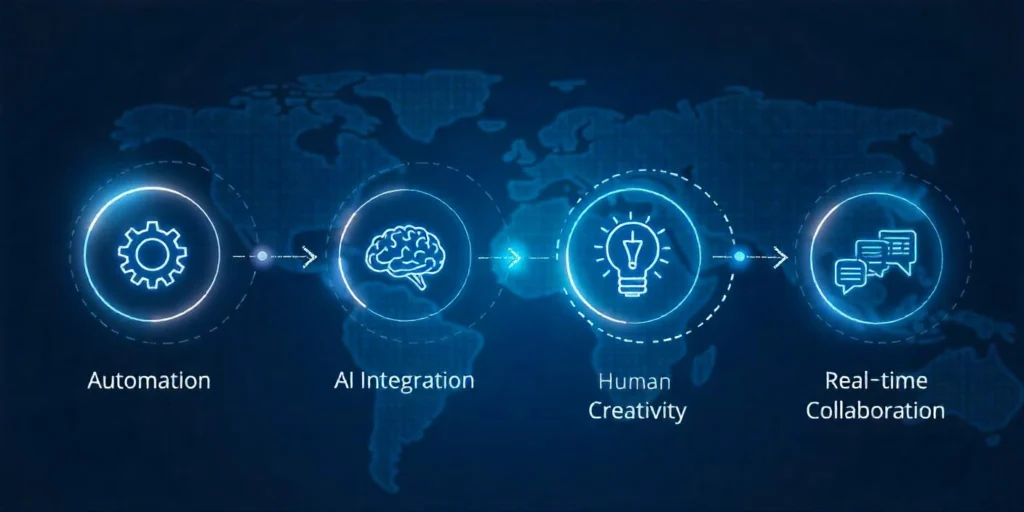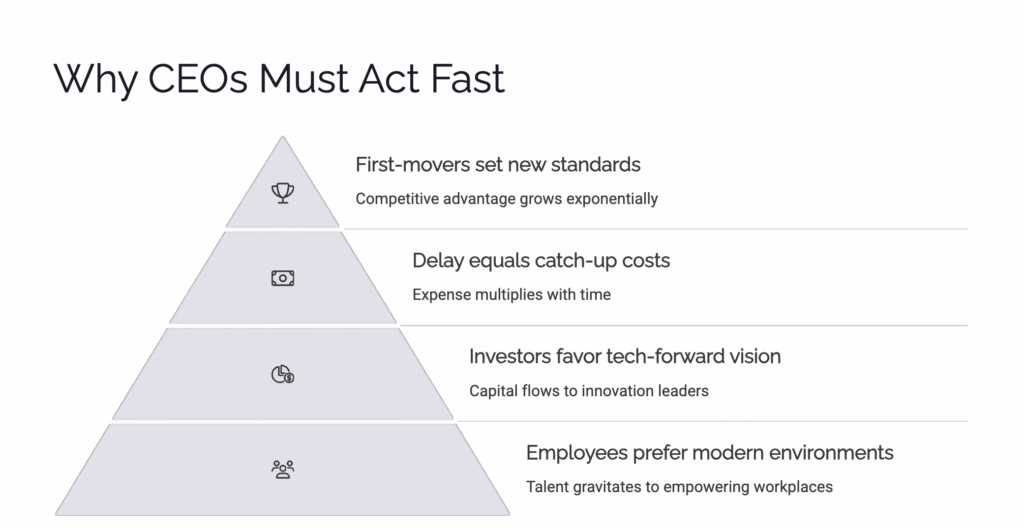At a recent CEO roundtable event we hosted, one business leader shared how he transformed his organisation through strategic automation. This article captures those key insights.
“How Do We Become a Tech Company That Happens to Sell Our Products?”
This question, posed repeatedly by a GMD in one of Africa’s largest conglomerates to his leadership team, captures the fundamental shift every CEO must embrace today. It’s not about being better at what you do—it’s about reimagining your entire business through a technology lens.
The Reality Check: We’re in a Rapid Tech Revolution.
The pace of technological change is accelerating beyond what most of us imagined. Artificial intelligence wasn’t a major conversation just a few years ago. Now it’s reshaping entire industries. For businesses that want to stay competitive and thrive, technology must be at the core of everything you do—not an add-on.
Customer expectations have skyrocketed. As customers ourselves, we demand rapid responses, seamless digital interactions, and personalised experiences. When your clients engage your HR services, they expect the same level of sophistication they get from Amazon or other tech-forward companies.
The Automation Success Story: Freeing People for Strategic Work.
Automation, when done right, doesn’t replace people, it unlocks their potential.
At one of the subsidiaries under a large conglomerate, the complete automation of financial payments and approval workflows led to an unexpected transformation. What began as a project to reduce bottlenecks in expense approvals ended up becoming a catalyst for workforce reinvention.

Before automation, employees were bogged down with repetitive, manual tasks—manually inputting payment requests, chasing approvals, double-checking ledgers, and reconciling errors. These tasks consumed hours, left little room for innovation, and often led to employee fatigue and disengagement.
But once these processes were fully automated—integrating AI-based validation, real-time tracking, and smart decision-routing—something remarkable happened.
These employees went from saying, “I do that task over and over and over again, I want something new”, to actually doing something new and being more productive for the business. That’s the real promise of automation—not replacing people, but empowering them.
This is the real promise of automation: to elevate human capacity. By stripping away the drudgery, it allows people to think, create, and lead.For CEOs and transformation leaders, this is a critical insight—automation is not about headcount reduction; it’s about capability expansion. It’s how organisations evolve from operational survival to strategic excellence.
The Four Elements of Modern Workforce Automation.
Forward-thinking organisations are moving beyond basic digitisation to create intelligent systems that enhance human potential.

The goal is not just efficiency, but synergy: machines handling what they do best, and people empowered to do what only they can.
Today’s most effective organisations blend four critical elements:
- Automation – Handles repetitive tasks seamlessly
- AI Integration – Powers smart decision-making
- Human Creativity – The irreplaceable human element
- Real-time Collaboration – Brings it all together
This isn’t about replacing humans—it’s about creating an environment where technology amplifies human capability.
Why CEOs Must Act Now!
The pressure on today’s CEOs isn’t just about performance—it’s about foresight. As the business landscape shifts rapidly toward digital-first models, the companies that thrive will be those whose leaders take proactive ownership of their transformation agenda.

Waiting is no longer an option. In fact, the real cost is in hesitation. Below are the key reasons CEOs must act now:
1. Set the Standard From the Top: Every CEO has a responsibility to ponder “How do I integrate automation into my processes? How do I make technology a key driver for long-term business growth and sustainability?”
When transformation is driven from the top, it makes life significantly easier for everyone else in the organisation.
2. The Cost of Delay: Here’s the hard truth – Delay equals increased costs. There’s no two ways about it. You can hold off today and say you’ll consider adoption next month, but it’s never going to get cheaper in the long run.
Invest now and you’ll immediately start seeing returns on those investments.
3. The Talent Reality: Capital flows to innovative leaders. Employees prefer modern environments. Talent gravitates toward empowering workplaces. If you’re not providing these, your best people will find organisations that do.
The window to lead is now. Delay invites disruption, while action unlocks growth, efficiency, and lasting relevance. The time to move isn’t tomorrow. It’s today.
Immediate Impact Areas for Your Organisation.
The most successful transitions often start small—targeting the areas where automation and AI can deliver quick, visible wins.
Focus your initial efforts on these high-impact areas:
1. Digital HR and Finance Integration
- Embedded finance and automated payroll systems
- Real-time expense and payment processing
2. AI-Powered Talent Management
- Recruitment systems that find the best talent faster
- Automated onboarding and performance tracking
3. Enhanced Customer Service
- Personalised interactions
- Real-time response systems that address clients by name
4. Data-Driven Decision Making
- Real-time insights driving strategy
- Predictive analytics for workforce planning
When you automate the core functions that power your people, processes, and performance, you position your organisation to scale smarter, operate leaner, and serve better. The future of work is already unfolding. By focusing on these high-impact areas, you’re not just catching up—you’re leaping ahead.
The Numbers Don’t Lie.
Organisations already on this path are seeing remarkable results:
- 70% of companies using AI-driven recruitment report faster time-to-hire
- 20-25% increase in operational efficiency through automated HR services
- 25% decrease in project overruns through intelligent management systems
These numbers aren’t projections—they’re proof that automation and AI are already transforming the way modern businesses operate. The data speaks for itself: organisations that embrace intelligent systems are faster, leaner, and more effective. If you want to lead in this new era, following the numbers isn’t just smart—it’s essential.
How to Get Started: The Practical Steps.
The journey toward automation doesn’t have to be overwhelming. It begins with clarity—knowing where to focus, who to work with, and how to bring your people along for the ride. These practical steps are designed to help you move from intention to execution, one smart decision at a time.
Step 1 – Audit Your Automation Opportunities: Don’t just copy what Company A or Company B is doing. Look within your own organisation. Start the audit within your scope of operations today.
Work with your internal teams (or partners who can guide you) to identify high-impact processes that would add immediate value. Make a comprehensive list across all your operations, then prioritize ruthlessly until you zero in on the initiatives that will have the most significant impact.
Step 2 – Partner Strategically: You don’t have to do this alone. Partner with strategic tech firms who can walk you through this journey and help you implement solutions that actually work.
Step 3 – Foster a Digital-First Culture: This transformation isn’t just about technology—it’s about changing how your entire organisation thinks about work, efficiency, and value creation.
The organisations that thrive tomorrow are the ones taking smart, strategic steps today.
The CEO’s Choice: Lead or Be Left Behind?
The question isn’t whether this transformation will happen—it’s whether you’ll lead it or be forced to catch up later at a much higher cost.
Organisations that crack this code don’t just become more efficient—they become fundamentally more competitive. They provide better service to clients, create more engaging environments for employees, and build sustainable competitive advantages.
The evidence is clear. The path is proven. The time is now.
The only question left is: When will you start your transformation?
The future belongs to CEOs who understand that technology isn’t just a tool—it’s the foundation of modern business success.






